
table of contents
- Plants from A to H
- Plants from J to P
- Plants from S to Z
- frequently asked Questions
Perennials form the basis of the garden. They are suitable for gardeners, are hardy, easy to care for and bloom. We have compiled a list of twelve popular varieties and tips on when to plant them for you.
In a nutshell
- Perennials are perennial, herbaceous, mostly hardy plants
- Subdivision according to height into high, medium-high and low upholstery or Ground cover shrubs
- Planting time mostly in spring or autumn
- Propagation by sowing or dividing
Plants from A to H
Columbine (Aquilegia)
The easy-care flower with its unusual shape is also popularly known as a fool's cap, devil's bell or dove flower. It fits in the cottage garden and is popular as a cut flower. If you remove the columbine's withered flowers in early summer, it will bloom again in autumn.

- Flower color: white, yellow, pink, red, blue, purple
- Flowering period: May to June
- Soil: well-drained, nutrient-rich, moist
- Location: sunny to partially shaded
- Characteristic: poisonous
- Planting: in spring or autumn
Tip: The perennial is often attacked by the columbine sawfly. In this case, a complete cut back is required.
Blue monkshood (aconitum napellus)
The blue flowers glow from afar. The flowering shoots can reach a height of 1.50 meters.
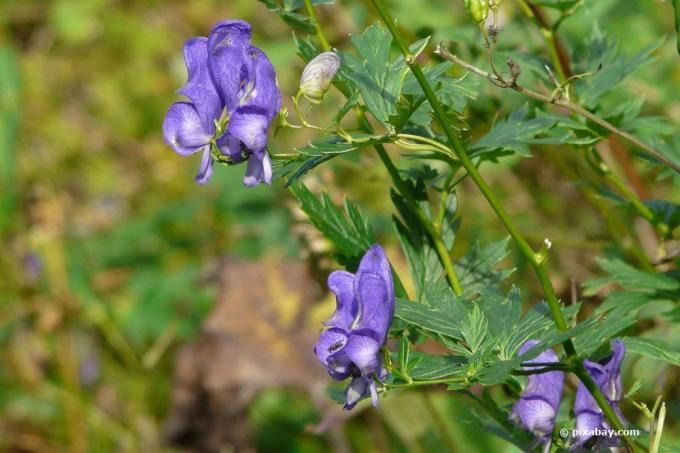
- Flower color: blue
- Flowering period: June to August
- Soil: sandy, loamy, nutrient-rich, moist
- Location: partially shaded to sunny, warm
- Characteristic: highly poisonous
- Planting time: in spring
Tip: Put horn shavings or compost in the planting hole. Plants benefit from regular fertilization with horn shavings.
Christmas rose (Helleborus niger)
In the middle of winter, the Christmas rose already produces its white flowers. They cannot stop even the remains of the snow. Christmas roses are suitable as cut flowers for the vase. However, they should not be cut when there is frost.
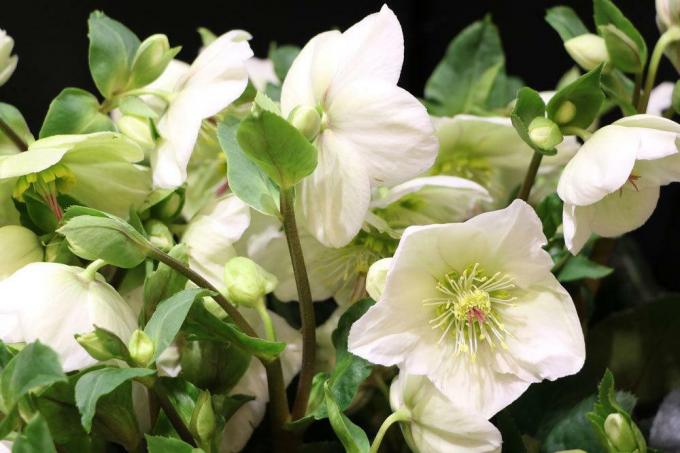
- Flower color: white
- Flowering period: January to April
- Soil: calcareous, nutrient-rich, well-drained
- Location: shady to partially shaded
- Characteristic: more than one hundred flowers with strong plants possible per season
- Planting: in August
Tip: Don't worry if your Christmas roses suddenly collapse. You are not frozen to death. It is a protective mechanism. In severe frost, the plants pull the water from the stems to protect them from frost damage.
Dalmatian bellflower (Campanula portenschlagiana)
The Dalmatian cushion bellflower is one of the most beautiful and long-lasting cushion perennials. It is suitable as a ground cover, grows in rock gardens, on dry stone walls and also unfolds its splendor in the flower box on the balcony.
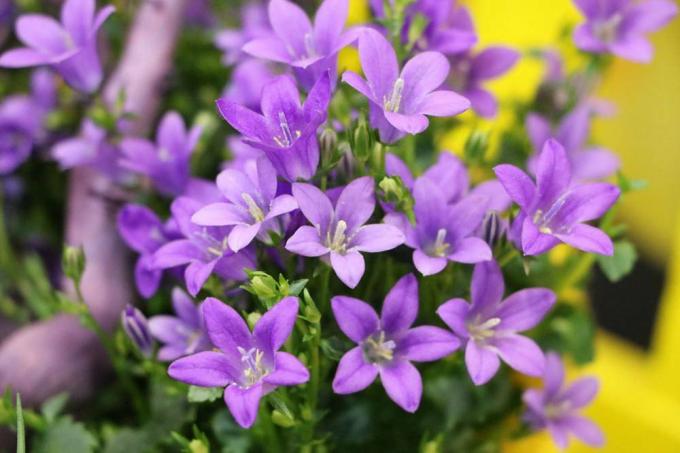
- Flower color: blue-violet
- Flowering period: June to September
- Soil: well drained, dry
- Location: sunny to partially shaded
- Characteristic: bee pasture
- Planting: from spring to autumn
Tip: The cushion bellflower is propagated by sowing or by dividing the plant in spring or autumn.
Dyer's chamomile (Anthemis tinctoria)
The dye chamomile gets its name because of its use as a dye plant. The small flowering plant looks attractive in cottage gardens and is also suitable for planting balcony boxes.

- Flower color: yellow
- Flowering period: June to September
- Soil: sandy, well drained, dry
- Location: sunny
- Characteristic: suitable as a cut flower
- Planting time: in autumn
Tip: Dyer's chamomile is also called dyer's chamomile. Bright yellow, unfilled flowers make them a favorite perennial in the garden and an important forage plant for bees, bumblebees and Co.
Lady's Mantle (Alchemilla)
Lady's mantle can be wonderfully combined with small bedding plants. The cushion-forming perennial grows reliably and can be easily propagated by dividing in spring. The yellow-green lady's mantle (Alchemilla xanthochlora) has been used as a medicinal herb for centuries.
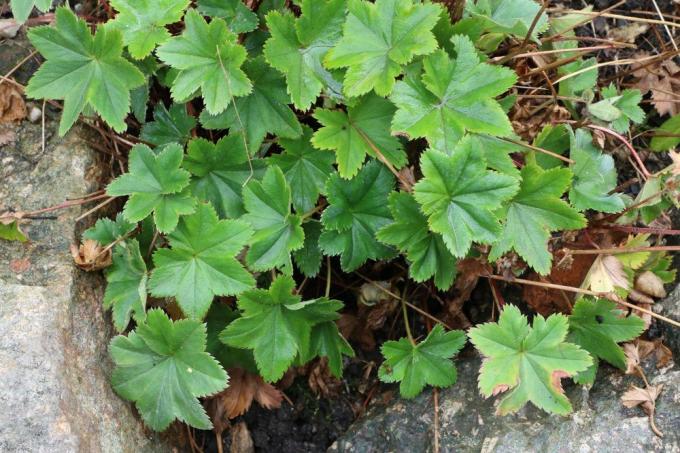
- Flower color: green-yellow
- Flowering period: June to August
- Soil: nutrient-rich, well-drained
- Location: partially shaded to sunny
- Characteristic: strong propagation by self-sowing
- Planting: in spring or autumn
Tip: Young or divided plants should be watered regularly after planting.
Hosta
Hostas do not convince with their flowers, but with their attractive foliage. They are ideal for shady locations.

- Flower color: white, light purple
- Flowering period: July to August
- Soil: sandy, loamy, well-drained, moist, rich in nutrients
- Location: shady to partially shaded
- Characteristic: colored leaves
- Planting: in the spring after the ice saints
Tip: Funkia look decorative as cut flowers in the vase.
Common carnation (Armeria maritima)
Carnations form dense cushions. They fit in rock gardens and are suitable as bed borders.

- Flower color: white, pink
- Flowering period: May to July
- Soil: sandy, dry, well-drained
- Location: sunny
- Feature: wind and weatherproof, very robust
- Planting: in March or April
Tip: It doesn't always have to be geraniums. Plant carnations in pots or window boxes. The glowing flowers can be seen from afar.
Hydrangea
Hydrangeas used to be considered old-fashioned. They were also called mother-in-law. Today there is hardly a flower lover who would like to do without the easy-care plant with the decorative blossom.
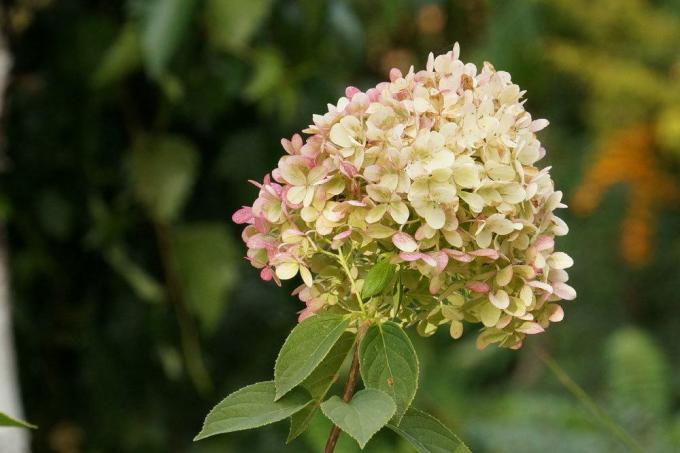
- Flower color: white, light green, pink, yellow, blue, purple
- Flowering period: May to July
- Soil: well drained, moist, slightly acidic
- Location: partially shaded
- Feature: pruning in spring or autumn
- Planting time: in spring
Tip: You don't have to do without the hydrangea blossom in autumn and winter either. Hang the flowers upside down to dry. The dried flowers are well suited for arrangements and look very elegant individually in the vase.
Plants from J to P
Japan Japanese anemone (Anemone japonica)
The easy-care Japanese autumn anemones are available in a large selection with single or double flowers in many colors.
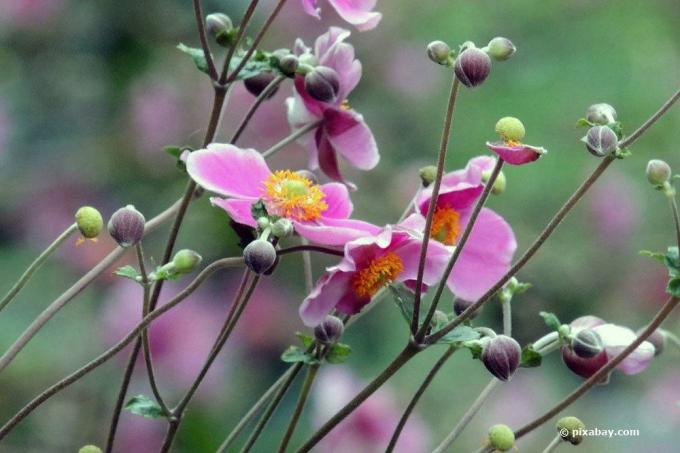
- Flower color: white, pink, red
- Flowering period: August to September
- Soil: nutrient-rich, well-drained, moist
- Location: partially shaded
- Characteristic: Propagation by seeds or runners
- Planting: in spring
Tip: Some varieties of the Japanese autumn anemones can grow to be more than a meter tall. In order to keep the filigree stems from snapping off, the elegant plants should be given a sheltered location.
Luminous lobelia (Lobelia cardinalis)
Grape-shaped inflorescences with bright red flowers attract the eyes of garden visitors. The glowing lobelia looks attractive in combination with blue or purple flowering plants. Bellflowers and Luminous Lobelia are a dream couple!

- Flower color: red
- Flowering period: July to September
- Soil: moist, rich in nutrients, avoid waterlogging
- Location: sunny
- Characteristic: together with low cushion perennials for Grave planting suitable
- Planting: from mid-May
Tip: Lobelia can be propagated by seeds. They are light germinators, the seeds must not be covered with sowing soil.
Ox-eye (Buphthalmum salicifolium)
The ox-eye with its bright yellow flowers is suitable for wild shrub gardens. It looks very similar to arnica.
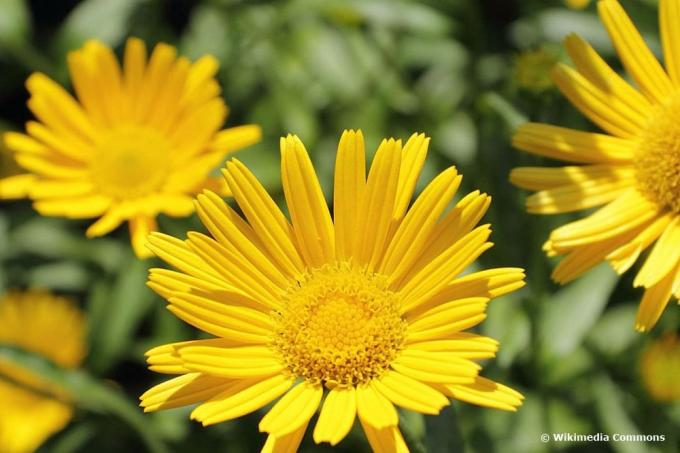
- Flower color: yellow
- Flowering period: May to September
- Soil: dry, calcareous, poor in nutrients
- Location: sunny
- Characteristic: bee pasture
- Planting: from March to October
Tip: Hardly any other perennial blooms as tirelessly as the ox-eye.
Pearl basket (Anaphalis triplinervis)
The low perennial impresses with shiny silvery leaves and delicate white flowers. Summer snow and silver rain are the most popular varieties.

- Flower color: white
- Flowering period: July to October
- Soil: calcareous, moderately rich in nutrients, well-drained, moist
- Location: sunny
- Characteristic: perfectly suitable as a border
- Planting time: in spring
Tip: After planting, you should water the pearl basket well. Once grown, the undemanding perennial hardly needs any care.
Splendid spar (astilbe)
Splendid sparrows, also known as astilbe, are a must in any garden. They come in small or large, with white, delicate purple or pink flowers. So that astilbe can still grow well before winter, the planting time of this perennial is recommended in autumn.

- Flower color: white, pink
- Flowering period: July to August
- Soil: well drained, moist, rich in nutrients
- Location: shady to partially shaded
- Characteristic: bee pasture
- Planting: in autumn
Tip: Regular compost increases the flowering ability of the splendid sparrows.
Purple bells (Heuchera)
The purple bell enchants with its filigree flowers and beautifully drawn leaves. It is one of the most popular ornamental foliage perennials.
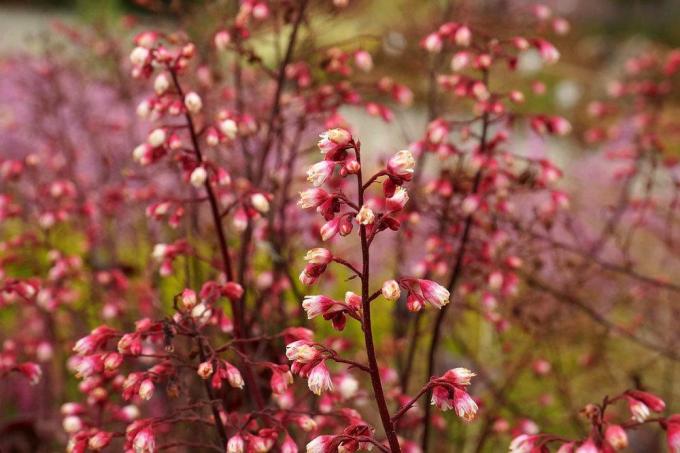
- Flower color: white, yellow, pink, red
- Flowering period: July to August
- Soil: sandy, well drained, humic
- Location: partially shaded
- Characteristic: tolerates short dry periods
- Planting: in spring
Tip: The range of Heuchera varieties is large. Choose from small, medium, or tall varieties depending on your needs.
Plants from S to Z
Sand thyme (Thymus serpyllum)
Bees and butterflies love its nectar, we love its aromatic scent and the blossoms of the cushion-forming perennial. The sand thyme fits perfectly in rock gardens, is suitable for roof greening and can be planted as a border.

- Flower color: pink
- Flowering period: June to August
- Soil: sandy, well drained, poor in nutrients
- Location: sunny, warm
- Characteristic: Use as a medicinal and aromatic plant
- Planting: from spring to autumn
Tip: Every three years, the sand thyme should be rejuvenated by dividing it.
Yarrow (Achillea)
The tall, richly blooming shrub should not be missing in cottage gardens.

- Flower colors: white, yellow, orange, red, pink
- Flowering period: July to September
- Soil: nutrient-rich, well-drained, dry
- Location: sunny, warm
- Characteristic: bee forage plant
- Planting: in spring or autumn
Tip: Water the root ball before planting. Put compost in the planting hole in poor soils.
Turkish poppy (Papaver orientale)
The Turkish poppy is also known as the herbaceous poppy. Huge flowers in enchanting colors attract bees, bumblebees and butterflies.

- Flower colors: white, pink, orange, red
- Flowering period: May to August
- Soil: nutrient-rich, well-drained
- Location: sunny, warm
- Characteristic: bee forage plant
- Planting: in spring or autumn
Tip: Cut off the yellowed leaves of the Turkish poppy after flowering. The perennial retreats into the ground in late autumn, only to sprout again the following spring.
Ornamental onion (Allium)
Ornamental onion with the glowing flower balls is an eye-catcher in every garden. The flower stalks are up to one meter high. Bees, butterflies and other flower-visiting insects are magically attracted to the decorative plant.
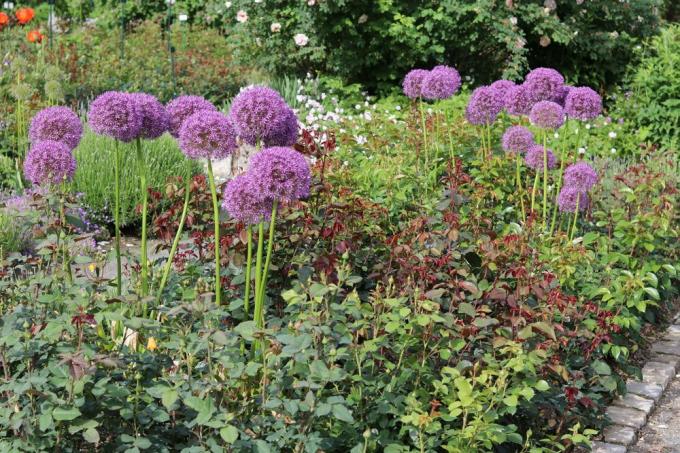
- Flower colors: white, pink, purple
- Flowering period: April to September
- Soil: nutrient-rich, well-drained, dry
- Location: sunny, warm
- Characteristic: Bee forage plant
- Planting: September to November
Tip: Fertilization in the spring after budding leads to a splendid bloom.
frequently asked Questions
Ask for shade perennials in the nursery. Funkia, Christmas roses and splendid spar, for example, feel very comfortable in the shade.
Loosen the bed for the perennial well at the recommended planting time. Remove all weeds. Dandelion, ground elder and bindweed compete with the young plants and impair their development. Loosen the root ball of purchased perennials. Put the plant in water for 20 minutes. Dig a planting hole. Put the plant in, fill in soil, fix the surface and water it well.
After flowering, you can divide perennials. Use a clean, sharp spade to do this. Cut off part of the plant and put it in a prepared planting hole filled with compost. The division of a perennial stimulates its growth and the formation of flowers.
Most perennials can be planted in spring or autumn after flowering. Follow the tips in our list or the information on the plant labels of purchased plants.


